Potez
75

Via Eric Bond
Potez75 |
 Via Eric Bond |
Looking like a left-over from World War II, the Potez 75 was the first aircraft built by the newly re-formed Société des Avions et Moteurs Henry Potez. The 75 was initially planned as a dedicated anti-tank aircraft, operating over future European battlefields. Its proposed role was to be a flying missile platform, able to counter any armored invasion of France, similar to the German invasion of World War II. It was designed to be easy to fly and maintain, able to operate alongside French Army tank units, away from roads and fixed airbases, using natural cover to "stalk" its targets.
The first prototype was built at Sartrouville in about five months time. The prototype featured a central nacelle containing the armored crew positions, nose-mounted gun and pusher Potez 8-D32 inverted V-8 engine. Twin booms extending from the wings carried a high-mounted horizontal tail. Fixed, spatted tricycle landing gear fitted with hydraulic wheel brakes allowed operation from unprepared ground. The nose was removable to allow easy access or switching out of the gun armament, which initially consisted of one 0.50 in machine gun or one heavy cannon (sources are not clear on which). An enclosed, armored observer/missile aimer's position was located behind the gun armament in the nose. Above and behind was positioned an open, armored pilot's position, with excellent viewing, described as "...being on the bridge of a small steamer." Access to the pilot's cockpit was via a swing-down door with integral steps. A reflector gunsight and standard blind-flying instruments were fitted in the pilot's cockpit. A standard French Army tank radio was also planned to be installed. The pusher engine was cooled via a ventral inlet containing a geared fan and filter, allowing the 75 to operate in a dusty environment without overheating. An automatic, constant speed propellor was fitted. Four Nord SS.10-derived anti-tank guided missiles were carried underneath the unswept, dihedraled wing.
Despite its ungainly appearance, by all accounts the Potez 75 was easy to fly and excelled in its planned operating environment: at low altitude, maneouvering around buildings, trees and other natural cover. It was evaluated against several de Havilland Vampire fighters, and was apparently difficult to find and "virtually impossible" to attack. The landing gear was described as being "spectacularly effective," and landing and take-off could be accomplished in about 100 yards. The controls were described as being "light and responsive." The 75 made its first public appearance at the 1953 Paris Air Show.
After evaluating it, the French Army and Air Force both rejected it for production. However, in 1955, the French Under-Secretary of State for War authorized modifying the Potez 75 as a ground support / counter-insurgency aircraft for use in France's North African colonies (variously described as a "colonial" or "police" aircraft). Sources are unclear if the existing prototype was modified or if a second prototype was built. At some point, the pilot's cockpit was modified with an enclosed canopy. The observer's position was also revised at some point with a large, bulged canopy. The armament was revised, with four 7.5 mm machine guns in the nose and eight unguided rockets under the wings and two SS.10 or SS.11 anti-tank missiles on underwing pylons near the wingtips. After weapons testing at Cazeux, the Potez 75 was sent to North Africa for further evaluation (possibly operational testing in Algeria). The testing was apparently successful, as 15 pre-production and 100 production aircraft were ordered in 1956. However, in 1957, apparently before any aircraft could be built, the order was cancelled due to budget reductions. Another possible reason for the cancellation was the advent of the helicopter. The French Army acquired 100 Sud-Ouest S.O.1221 Djinn light helicopters, which were also tested with Nord ATGMs. The anti-armor flying missile platform role the Potez 75 was intially designed for ended up being filled by the attack helicopter. It is interesting to note the similarities between the Potez 75 and another, more successful anti-tank aircraft: the Fairchild-Republic A-10 Thunderbolt II. Both have features reminiscent of World War II attack aircraft. Indeed, one writer described the Potez 75 as being an aircraft "...which might have suited the German, Stuka pilot, Ernst Rudel". Both were designed to be simple to operate, with short take-off and landing capabilities. Both featured armored crew protection and were designed around a state-of-the-art (for the time) anti-armor weapon. Their wings are similar in design, and both have twin tails. The A-10, however, received a production order and saw action in several conflicts.
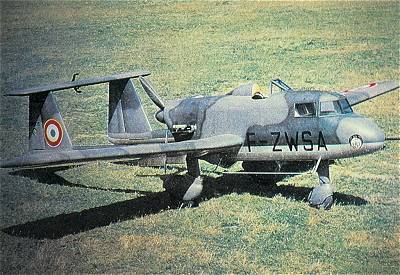 Potez 75 prototype, F-ZWSA |
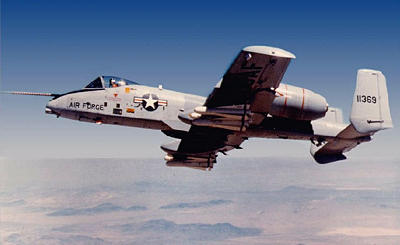 Fairchild-Republic YA-10A Thunderbolt II prototype, USAF s/n 71-1369. |
Timeline
 "Potez 75 carrying S.S.10 air-to-ground missiles." (Flightglobal/Archive 1956) |
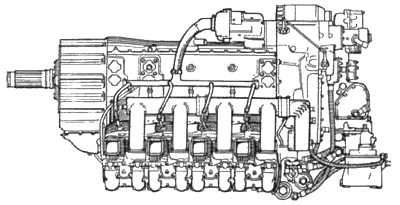 Potez 8-D.30 engine (Flightglobal/Archive 1956) |
 "Anti-tank rockets on a Potez 75. Part of a missile pylon is visible on the extreme left." (Flightglobal/Archive 1956) |
| Specifications | 75 |
| Designer(s) | Delaruelle |
| Mission Type | Anti-tank, COIN (COunter-INsurgency), ground support |
| Powerplant | 1 x 450 hp Potez 8D.2 inline, or 1 x Potez 8-D.32 inverted-vee 8 cylinder inline, 350 hp @ sl, 480 hp @ T-O |
| Dimensions | |
| Span | 42 ft 11.75 in (13.1 m) |
| Length | 29 ft 1 in - 30 ft 0.25 in (9.15 - 9.16 m) |
| Height | 8 ft 10 in - 9 ft 0.25 in (2.70 - 2.75 m) |
| Wing area | ? |
| Weights | |
| Empty | 3,968 lb (1,800 kg) |
| Loaded (all-up) | 5,280 lb (2,400 kg) |
| Take-off | -- |
| Max | 5,511 lb (2,500 kg) |
| Performance | |
| Max speed (fully loaded) | 171 mph @ altitude (275 km/hr) |
| (1.5 hr of fuel) | 215 mph @ 1,200 ft (350 km/hr @ 366 m) |
| Cruise speed (@ 75% power) | 135 - 140 mph (225 km/hr) |
| Initial climb rate | 1,570 ft/min (8 m/sec) |
| Service ceiling | ? |
| Range | 435 - 466 miles (700 - 750 km) |
| Endurance | ? |
| Take-off distance | 190 yds (175 m) |
| Landing distance | 180 yds (165 m) |
| Take-off to clear 15 m obstacle | 515 yds (470 m) |
| Landing distance to clear 15 m obstacle | 300 yds (275 m) |
| Landing speed | 68 mph (110 km/hr) |
| Armament | |
| Crew | Two (pilot, observer/weapon controller) |
| User | France (evaluated by Armée de l'Air and Aviation Legere de L'Armee de Terre); also evaluated by Venezuela |
| Number built | Two prototypes 15 pre-production ordered, none built 100 production ordered, none built |
| Construction Numbers | 01, ? |
| Serial Numbers (civil registration) | F-ZWSA, F-WGVK, F-MAFY |
| Test Pilots | Potez: Georges Détré Also flown by Jacques Noetinger (aeronautical information officer), Oswald Gibelli (Venezuela), C. M. Lambert (Flight) |
 Potez 75 F-ZWSA |
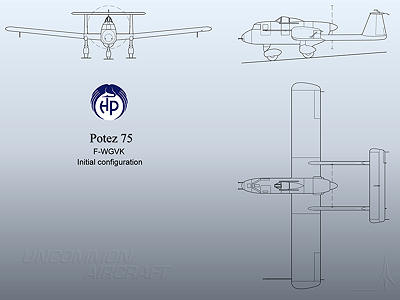 Potez 75 F-WGVK, initial configuration |
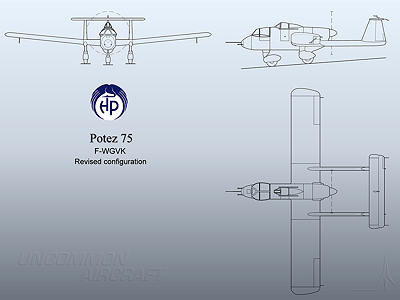 Potez 75 F-WGVK, revised configuration |
Profiles
I created these profiles based on as many photos of the Potez 75 as I could find. In addition to the photos I have posted here,
I referenced the following photos online:
 Potez 75 F-ZWSA, unpainted natural metal |
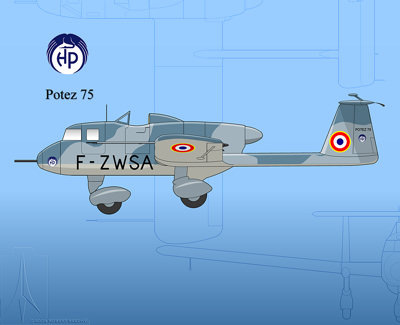 Potez 75 F-ZWSA, camouflage |
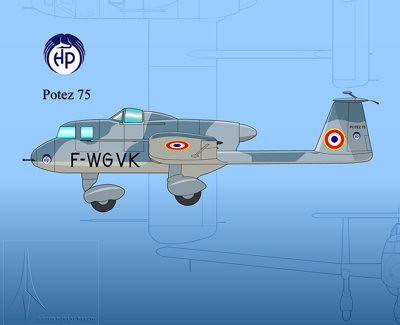 Potez 75 F-WGVK, initial configuration |
 Potez 75 F-WGVK, revised configuration |
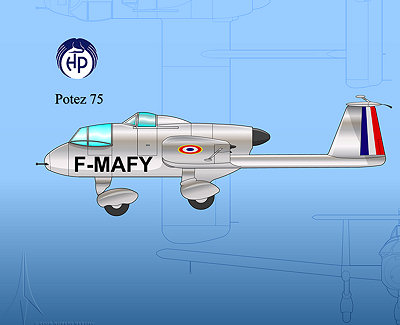 Potez 75 F-MAFY, unpainted natural metal |
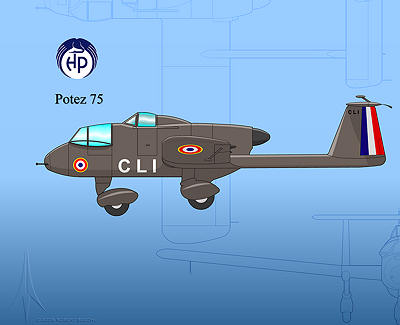 Potez 75 as it might have appeared in French Army service. |
 Potez 75 as it might have appeared in Venezuelan service. |
 "Layout of the pilot's spacious cockpit, forward of which can be seen the missile aimer's access door." (Flightglobal/Archive 1954) |
 "Although well above its operating height, the Potez 75's camouflage blends well with its background of French countryside. M. Noetinger is at the controls." (Flightglobal/Archive 1954) |
Web Links
Sources
| [ | Home | | | About | | | Contact | | | Top | ] |
© 1997-2005, Robert Beechy
http://fire.prohosting.com/uncommon/aircraft/75/index.html
Originally posted 30 August 1998
Modified: 01/05/2009